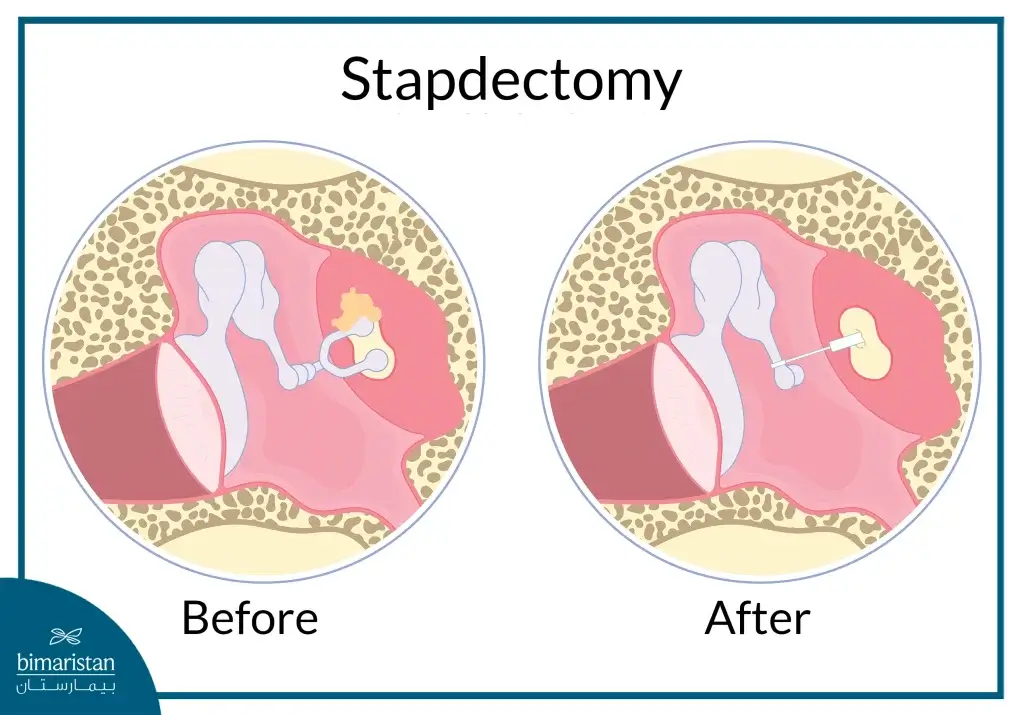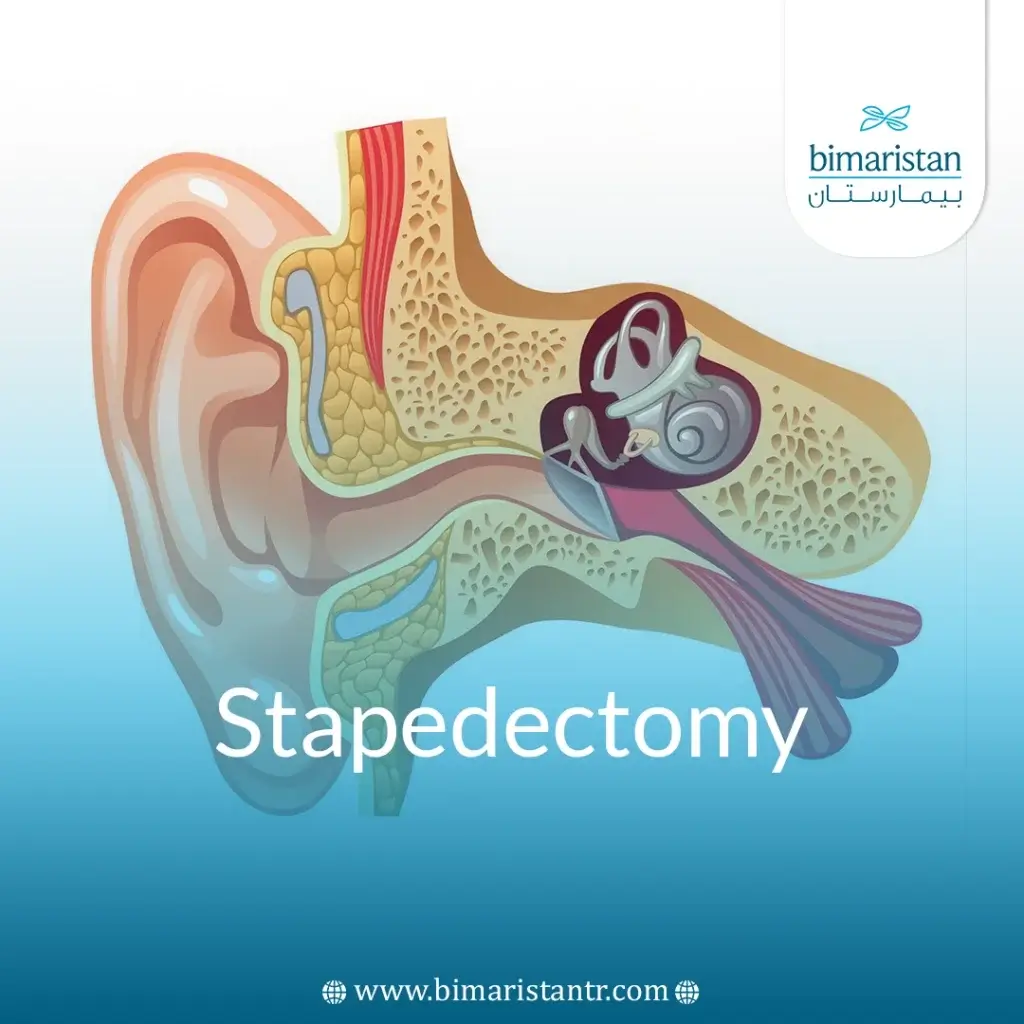Do you suffer from progressive hearing loss or persistent tinnitus? The cause may be stapes osteosclerosis, one of the leading causes of conductive hearing loss. Fortunately, stapedectomy provides an effective solution to restore hearing with high precision. In this article, we take you on a science-based tour to understand stapedectomy, its indications, outcomes, and everything you need to know to make this decision.
What is otosclerosis?
Otosclerosis is a disorder that leads to progressive hearing loss due to abnormal bone growth in the middle ear, particularly in the stapes bone, one of the bones responsible for transmitting sound to the inner ear. This bone growth hinders the movement of the stapes and prevents sound vibrations from traveling normally, leading to hearing loss. Common symptoms include hearing loss in one or both ears, ringing in the ears (tinnitus), and occasionally dizziness or imbalance. Otosclerosis is often hereditary and is more common in women, especially during pregnancy. The condition is usually diagnosed through an audiogram, and treatment options include the use of hearing aids, medications to slow the deterioration, or stapedectomy surgery to effectively restore hearing.
What is a stapedectomy?
Stapedectomy is a surgical procedure used to treat conductive hearing loss caused by otosclerosis, a condition in which the stapes, one of the three small bones in the middle ear, becomes unable to vibrate normally. During the procedure, the damaged bone is removed and replaced with a prosthesis that allows the transmission of sound to the inner ear to be restored.
The surgery is usually performed through the ear canal, where the eardrum is lifted, the stapes bone is carefully removed, the prosthesis is implanted, and a graft is often used to close the surgical opening. This surgery significantly improves hearing in most patients, although there are some potential risks such as dizziness, hearing loss, or facial nerve injury. However, it is a safe and effective procedure when performed by a specialized surgeon.

When is a stapedectomy recommended?
The surgery aims to replace the fixed stapes bone with a prosthesis, which allows for improved sound conduction and partial or full restoration of hearing in most patients and is recommended in the following cases:
- Definite otosclerosis: The most common reason for stapedectomy.
- Severe conductive hearing loss: Especially if it exceeds 25 dB at certain frequencies.
- Mixed hearing loss: Surgery may be considered if the conductive component is significant.
- Ineffective hearing aids: When hearing aids do not result in sufficient improvement.
- Prioritize the weaker ear: Surgery is usually performed on the ear with the weaker hearing first.
- Good general health: The patient must be able to tolerate anesthesia.
- Deformities or injuries to the kneecap: Rare but may require surgery.
Stapedectomy steps
This delicate operation is performed to improve hearing by replacing the stapes bone with a prosthesis:
- Anesthesia and incision: A small incision is made inside the ear canal, and the eardrum is removed to access the middle ear.
- Accessing the stapes bone: The surgeon uses a surgical microscope to magnify the view, allowing for precise visualization of the stapes bone and adjacent structures.
- Removal of the stapes bone: The hardened bone is carefully removed either completely or partially depending on the degree of hardening and the anatomical condition.
- Prosthetic implant: A small prosthesis (piston-like) is placed between the anvil bone and the oval window to serve as the stapes bone’s function in transmitting sound vibrations.
- Graft closure: A patch of the patient’s tissue (such as fascia or vein) is placed to stabilize the prosthesis and prevent fluid leakage.
- Return the eardrum: The eardrum is gently returned to its normal position after the prosthesis has been fitted.
- Filling the ear canal: A special material is placed inside the canal to support healing and prevent any leaks or infections.
- Recovery phase: Recovery lasts from several days to weeks, and a gradual improvement in hearing is usually seen within the first month after surgery.
Risks and possible complications of stapedectomy
Although stapedectomy is an effective procedure to improve hearing, it is not without some potential complications, which may be temporary or rare in some cases.
- Hearing loss: This can be temporary or permanent, and is an undesirable complication even though the surgery aims to improve it.
- Dizziness or lightheadedness: One of the most common side effects, and often goes away within days.
- Tinnitus: Annoying ringing or buzzing in the ear may appear after the procedure.
- The prosthesis malfunctions or moves: The implanted device may dislocate or fail to perform its function, necessitating a repeat surgery.
- Peripheral lymphatic fistula: Leakage of fluid in the inner ear, which may cause dizziness or additional hearing loss.
- Granuloma: A rare tissue growth that can affect the success of the procedure and require additional treatment.
Difference between stapedectomy and hearing aids
. Stapedectomy surgery and hearing aids are used to treat hearing loss, but the treatment mechanism and goals differ between the two methods.
| Element | Stapedectomy | Hearing aids |
|---|---|---|
| Type of treatment | Surgical procedure | Electronic External Device |
| Objective | Treating the structural cause of hearing loss (otosclerosis) | Improving hearing through sound amplification |
| Mechanism of action | Replacing a damaged kneecap with an artificial limb | Picking up sounds, amplifying them, and delivering them to the ear |
| When is it recommended? | In cases of confirmed otosclerosis and conductive hearing loss | In different types of hearing loss (conductive, neurological, or mixed) |
| Expected results | May restore hearing to a near-normal level | Improved hearing without treating the underlying cause |
| Continuity | Often a permanent result (if the surgery is successful) | Requires constant use and regular maintenance |
Stapedectomy is a precise and effective surgical procedure in the treatment of conductive hearing loss due to otosclerosis. Despite the challenges and potential risks, clinical results show high success rates and significant improvement in hearing quality in carefully selected patients. Advances in surgical instruments and microsurgical techniques have improved the accuracy and safety of the procedure, making it a crucial treatment option in modern otology.
Sources:
- Stapedectomy.co.uk. (n.d.). Surgery for Otosclerosis. Retrieved July 21, 2025
- NHS. (2023, January 9). Otosclerosis. NHS. Retrieved July 21, 2025
